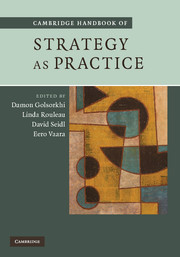Book contents
- Frontmatter
- Contents
- List of figures
- List of tables
- List of contributors
- Introduction: What is Strategy as Practice?
- PART I ONTOLOGICAL AND EPISTEMOLOGICAL QUESTIONS
- PART II THEORETICAL DIRECTIONS
- 7 Giddens, structuration theory and Strategy as Practice
- 8 An activity-theory approach to Strategy as Practice
- 9 A Bourdieusian perspective on strategizing
- 10 A Wittgensteinian perspective on strategizing
- 11 A Foucauldian perspective on strategic practice: strategy as the art of (un)folding
- 12 A narrative approach to Strategy as Practice: strategy making from texts and narratives
- PART III METHODOLOGICAL TRACKS
- PART IV APPLICATION VARIATIONS
- Author Index
- Index
- References
8 - An activity-theory approach to Strategy as Practice
Published online by Cambridge University Press: 05 October 2012
- Frontmatter
- Contents
- List of figures
- List of tables
- List of contributors
- Introduction: What is Strategy as Practice?
- PART I ONTOLOGICAL AND EPISTEMOLOGICAL QUESTIONS
- PART II THEORETICAL DIRECTIONS
- 7 Giddens, structuration theory and Strategy as Practice
- 8 An activity-theory approach to Strategy as Practice
- 9 A Bourdieusian perspective on strategizing
- 10 A Wittgensteinian perspective on strategizing
- 11 A Foucauldian perspective on strategic practice: strategy as the art of (un)folding
- 12 A narrative approach to Strategy as Practice: strategy making from texts and narratives
- PART III METHODOLOGICAL TRACKS
- PART IV APPLICATION VARIATIONS
- Author Index
- Index
- References
Summary
An activity-theory approach to Strategy as Practice
This chapter introduces activity theory as an approach for studying Strategy as Practice. Activity theory conceptualizes the ongoing construction of activity as a product of activity systems, comprising the actor, the community with which that actor interacts and those symbolic and material tools that mediate between actors, their community and their pursuit of activity. Activity theory has its roots in Russian social psychology. Russian cultural historical activity theory, as developed by Vygotsky (1978), initially conceptualized early childhood development through children's interaction in activities with their community. His followers, particularly Leontiev (1978), developed this theory more widely to encompass the interaction between the individual and the collective in the pursuit of activity. Activity theory has been widely adopted within the fields of education and human–computer interaction (Kaptelinin and Nardi 2006), as well as being developed in a particular way by Engeström (1990) for examining work practices in a range of contexts. More recently it has been used within organization theory to examine organizational and strategy practice (e.g. Blackler 1993, 1995; Blackler et al. 2000; Groleau 2006; Jarzabkowski 2003, 2005). Activity theory provides a resource for analysing the interaction between practitioners, practices and praxis through the study of activity systems.
In this chapter, I shall explain some specific concepts associated with activity theory and indicate its value for studying Strategy as Practice as it is socially accomplished by individuals in interaction with their wider social group and the artefacts of interaction.
Information
- Type
- Chapter
- Information
- Cambridge Handbook of Strategy as Practice , pp. 127 - 140Publisher: Cambridge University PressPrint publication year: 2010
References
Accessibility standard: Unknown
- 15
- Cited by
